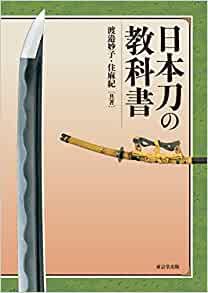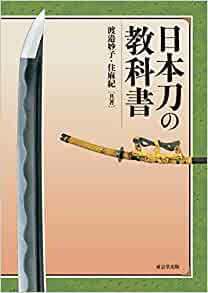渡邉妙子、住麻紀 共著「日本刀の教科書」東京堂出版
「日本刀を買いたいんだけど、どこで買えますか」そんな質問をされたことがありますか。ごくまれに訪日外国人から聞かれたことがあります。刀剣ショップで買えると思うのですが、購入許可が要るのか、出国の際の手続きはどうか、また、出身国に持ち込めるのかなどケースバイケースで、すぐに答えられる質問ではありません。お土産用の模造等を紹介するぐらいしかできませんでした。
日本刀の展示会にも何度か足を運びましたが、まだまだ鑑賞できるレベルの知識がないため、なかなか楽しむまでには程遠いです。そんな中、新書版の書物をなんどか読んだことがある渡邉妙子さんの著書に本書があることを知って、購入しました。元々、渡邉さんの所属する美術館で開催していた講座内容を本にまとめたそうです。
第1章は、日本刀の知識を紹介しています。そもそも日本刀等は何かという定義から始まり、日本刀の作り方を解説しています。この作り方については勉強しておいて損はないと思います。そういえば文科省がYoutubeで刀の作り方のビデオをアップしています。文科省以外でもYoutubeで探すと、いろいろ出てくるので、本書の文字だけによる解説では、十分に理解しずらい方は、動画を探して見ることをおすすめします。
それから、日本刀の種類、日本刀のみどころが続きます。全体的な形状の鑑賞から、反り、鎬、棟など、まず言葉と部位の対応から頭に入れておく必要があります。刀が好きな方は、刀文や作成時に出来たわずかな模様に美しさを感じるようです。
また、時代の変遷による、それぞれの時代の日本刀の特徴についても語られています。日本刀は実用品として発展しただけでなく、美術品あるいは神様への奉納品としても発展しています。人を斬る道具としての側面だけでは、恐ろしく感じてしまい、敬遠する方もいるでしょうが、美術品として捉えなおすと、興味が湧いてくるかもしれません。
第二章では、歴史にみる日本刀と題して、名工の紹介から始まります。三条小鍛冶宗近、粟田口藤四郎吉光など、京都の神社にゆかりの深い人物や、正宗、村正など、名前だけは聞いたことがある人物も網羅されています。作る側だけでなく、日本刀を愛した人々として、坂上田村麻呂、後鳥羽上皇、織田信長、豊臣秀吉、徳川家康、明治天皇を紹介しています。
この一冊で、知識については十分だと思います。あとはどれだけ関心を持って、日本刀に接することができるかです。展示会等にこまめに出向いて、自分なりの鑑賞方法を身に付けていければと考えています。(完)

価格:3,520円
(2021/8/29 12:36時点)
感想(1件)
Textbook of Japanese Swords (English)
Taeko Watanabe and Maki Sumi, “Textbook of Japanese Swords,” Tokyo Do Publishing Co.
Have you ever been asked, “I want to buy a Japanese sword, where can I buy one?” In rare cases, I have been asked this question by foreigners visiting Japan. I think they can buy them at sword stores, but it depends on the case, such as whether they need permission to buy them, what the procedures are when they leave Japan, and whether they can bring them into their country of origin. The only thing I could do was to introduce some imitations for souvenirs.
I have visited several exhibitions of Japanese swords, but I am far from enjoying them because I do not yet have the level of knowledge to appreciate them. In such a situation, I bought this book when I found out that it was written by Taeko Watanabe, whose books I have read several times in the new book version. This book is based on the lectures that Ms. Watanabe originally held at the museum she belongs to.
Chapter 1 is an introduction to the knowledge of Japanese swords. It starts with a definition of what a Japanese sword is, and then explains how to make a Japanese sword. I think it would be good to learn how to make a Japanese sword. By the way, the Ministry of Education, Culture, Sports, Science and Technology has uploaded a video on how to make a sword on Youtube. If you look for other videos on Youtube, you will find many more, so if you have trouble understanding the text-only explanations in this book, I recommend that you look for videos.
This is followed by the types of Japanese swords and the highlights of Japanese swords. The first thing you need to know is the correspondence between the words and the parts of the sword, such as Warp, Shinogi, and Mune. If you like swords, you will find the beauty in the sword design and the slight patterns made during the creation process.
It also discusses the characteristics of Japanese swords in different periods of time. The Japanese sword has developed not only as a practical tool, but also as a work of art or an offering to the gods. Some people may feel intimidated by the sword only as a tool for slaying people, but if you look at it again as a work of art, you may become more interested in it.
Chapter 2, titled “Japanese Swords in History,” begins with an introduction to master swordsmiths. It covers people who were closely associated with Kyoto shrines, such as Sanjo Kokoji Munechika and Awataguchi Toushiro Yoshimitsu, as well as people whose names we have heard before, such as Masamune and Muramasa. In addition to the wordsmiths, the book introduces people who loved Japanese swords, such as Tamuramaro Sakanoue, Emperor Go-Toba, Nobunaga Oda, Hideyoshi Toyotomi, Ieyasu Tokugawa, and Emperor Meiji.
I think this book is enough for the knowledge. What remains to be seen is how much interest I will have in Japanese swords. I would like to visit exhibitions frequently and learn how to appreciate Japanese swords in my own way. Thank you. (End)
Manuel des sabres japonais (Français)
Taeko Watanabe et Maki Sumi, “Textbook of Japanese Swords”, Tokyo Do Publishing Co.
Vous a-t-on déjà demandé : ” Je veux acheter un sabre japonais, où puis-je en acheter un ? “. Dans de rares cas, cette question m’a été posée par des étrangers en visite au Japon. Je pense qu’ils peuvent les acheter dans des magasins de sabres, mais cela dépend des cas, notamment s’ils ont besoin d’une autorisation pour les acheter, quelles sont les procédures à suivre lorsqu’ils quittent le Japon, et s’ils peuvent les ramener dans leur pays d’origine. La seule chose que je pouvais faire était d’introduire quelques imitations pour les souvenirs.
J’ai visité plusieurs expositions de sabres japonais, mais je suis loin d’en profiter car je n’ai pas encore le niveau de connaissance nécessaire pour les apprécier. Dans une telle situation, j’ai acheté ce livre lorsque j’ai découvert qu’il était écrit par Taeko Watanabe, dont j’ai lu plusieurs fois les livres dans leur nouvelle version. Ce livre est basé sur les conférences que Mme Watanabe a tenues à l’origine au musée auquel elle appartient.
Le chapitre 1 est une introduction à la connaissance des sabres japonais. Il commence par une définition de ce qu’est un sabre japonais, puis explique comment fabriquer un sabre japonais. Je pense qu’il serait bon d’apprendre à fabriquer un sabre japonais. À propos, le ministère de l’éducation, de la culture, des sports, des sciences et de la technologie a mis en ligne une vidéo sur la fabrication d’un sabre sur Youtube. Si vous cherchez d’autres vidéos sur Youtube, vous en trouverez beaucoup plus. Si vous avez du mal à comprendre les explications textuelles de ce livre, je vous recommande de chercher des vidéos.
Viennent ensuite les types de sabres japonais et les points forts des sabres japonais. La première chose que vous devez savoir est la correspondance entre les mots et les parties du sabre, comme Warp, Shinogi et Mune. Si vous aimez les sabres, vous trouverez la beauté dans la conception du sabre et les légers motifs réalisés au cours du processus de création.
Il aborde également les caractéristiques des sabres japonais à différentes époques. Le sabre japonais s’est développé non seulement comme un outil pratique, mais aussi comme une œuvre d’art ou une offrande aux dieux. Certaines personnes peuvent se sentir intimidées par le sabre uniquement en tant qu’outil pour tuer des gens, mais si vous le regardez à nouveau comme une œuvre d’art, vous pouvez vous y intéresser davantage.
Le chapitre 2, intitulé ” Les épées japonaises dans l’histoire “, commence par une présentation des maîtres épéistes. Il couvre des personnes qui étaient étroitement associées aux sanctuaires de Kyoto, comme Sanjo Kokoji Munechika et Awataguchi Toushiro Yoshimitsu, ainsi que des personnes dont nous avons déjà entendu les noms, comme Masamune et Muramasa. En plus des maîtres des mots, le livre présente des personnes qui ont aimé les sabres japonais, comme Tamuramaro Sakanoue, l’empereur Go-Toba, Nobunaga Oda, Hideyoshi Toyotomi, Ieyasu Tokugawa et l’empereur Meiji.
Je pense que ce livre est suffisant pour les connaissances. Ce qui reste à voir, c’est l’intérêt que je porterai aux sabres japonais. J’aimerais visiter fréquemment des expositions et apprendre à apprécier les sabres japonais à ma façon. Je vous remercie. (Fin)
